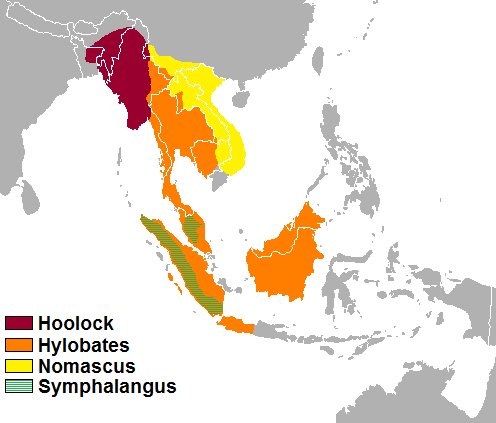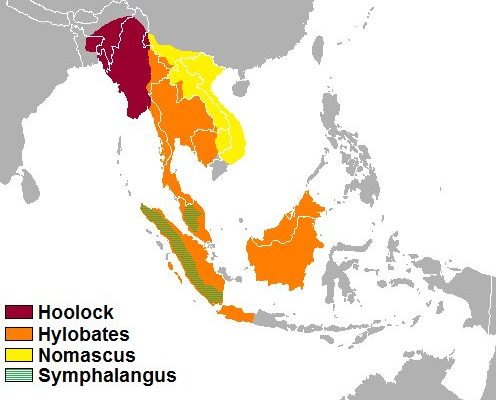
Imagine stepping into a lush jungle filled with vibrant greenery and sounds of nature all around. That’s pretty much what gibbons experience every day. These incredible primates thrive in tropical and subtropical forests, where they can swing from branch to branch. Their homes are not just about trees, though; they also need a healthy environment filled with food and protection. So, let’s take a closer look at the habitat and distribution of gibbons, and what makes it crucial for their survival.
Gibbon Family: An Overview
Before diving into their habitats, it’s important to know a bit about gibbons themselves. They belong to the family Hylobatidae, which includes about 18 different species, like the lar gibbon, white-cheeked gibbon, and the black gibbon. These small apes are known for their long arms and remarkable agility. They spend most of their time in trees, using their swinging skill, called brachiation, to move around.
Gibbons are often referred to as the “lesser apes” because they aren’t as big as their cousins, the great apes. However, they have a significant role in the ecosystem, helping to disperse seeds and maintain forest health. What they lack in size, they make up for in their vibrant social structures and vocalizations. Believe it or not, they can sing complex songs to communicate with each other, which can travel long distances in the jungle!
Natural Habitats of Gibbons
Gibbons primarily inhabit tropical and subtropical forests across Southeast Asia. Here’s where you can find them:
- Rainforests: Dense, lush rainforests provide the best conditions for gibbons. The tall trees allow them to swing freely while offering a variety of fruits and leaves for food.
- Deciduous forests: These forests lose their leaves in winter but still provide a suitable environment for gibbons. They adapt well to changing seasons and can find food even when the trees are bare.
- Monsoon forests: Gibbons also thrive in regions with seasonal rains. These forests bloom during the rainy season, which gives gibbons a rich source of food.
The type of forest impacts the specific species of gibbon living there, as each has adapted to its environment over time. For example, some species prefer thick canopies where they can hide from predators, while others might thrive in more open areas.
Geographical Distribution of Gibbons
Gibbons are scattered across multiple countries in Southeast Asia. Here’s where you can find them:
- Indonesia: Home to the largest number of gibbon species, Indonesia’s islands offer a range of habitats, from dense rainforests to mangrove swamps.
- Thailand: The tropical forests here are perfect for gibbons, and you might spot them in national parks like Khao Yai.
- Vietnam: Various gibbon species inhabit the forests, with conservation efforts in place to protect their dwindling numbers.
- Malaysia: Gibbons are found in both Peninsular Malaysia and Borneo, where ongoing deforestation threatens their habitats.
- Bangladesh and Myanmar: These regions are also home to gibbons, with certain species adapted to the unique forest structures found here.
As you can see, these little apes are a bit of a wanderer, adjusting to the various types of forests in Southeast Asia. Their distribution is closely tied to the forest cover in these areas, highlighting the importance of conservation efforts to ensure their survival.
Gibbon Habitat Requirements
So, what do gibbons need in their habitats? Understanding this is key to helping them thrive:
- Tree Density: Gibbons need lots of trees to thrive. The more dense the forest, the easier it is for them to find food and avoid predators.
- Food Source: Their diet mainly consists of fruits, leaves, and flowers. A healthy habitat needs to be plentiful in these food sources, allowing gibbons to live and grow.
- Water Access: While gibbons are mostly arboreal, they still require access to fresh water, usually found in the form of streams or rainfall in their habitat.
The health of their habitat directly impacts their populations. If the trees are cut down or the forest is altered, gibbons can face serious challenges, including starvation and increased predator encounters.
The Impact of Habitat Loss
Unfortunately, gibbons face significant threats due to habitat loss. As human activity encroaches on their natural environments, the consequences can be dire:
- Deforestation: Logging and land conversion for agriculture are major culprits. When forests are cut down, gibbons lose their homes and food sources.
- Fragmentation: Even if some tree cover remains, fragmented forests can isolate gibbon populations, making it hard for them to find mates and communicate.
- Climate Change: Changes in temperature and rainfall patterns can impact the growth of forests and the availability of food, further straining gibbon lives.
It’s heartbreaking to think about, but we can help make a difference by supporting wildlife conservation efforts. By promoting awareness and sustainable practices, we can ensure that these incredible creatures continue to swing through the trees for generations to come.
Conservation Efforts for Gibbons
Fortunately, various organizations and governments are working hard to protect gibbons and their habitats. Here’s what’s being done:
- Protected Areas: Creating national parks and wildlife reserves helps secure safe spaces for gibbons to thrive without human interference.
- Awareness Campaigns: Educating local communities about the importance of gibbons can foster appreciation and support for conservation.
- Reforestation: Planting trees in deforested areas can help restore habitats and provide a safer environment for gibbons.
These efforts are crucial for ensuring the future of gibbons. By protecting their habitats and raising awareness, we can help these agile apes survive and flourish in the wild.
Gibbons are remarkable creatures with a unique place in our world. Their habitats, rich with biodiversity and alive with the sounds of nature, are essential for their survival. Understanding where gibbons live and the challenges they face gives us a better perspective on why it’s important to protect these environments.
As we learn more about these incredible primates and their homes, we become more empowered to help. Whether it’s through conservation efforts, supporting local initiatives, or simply spreading the word, every little bit counts. By appreciating and safeguarding their habitats, we can ensure that gibbons continue to swing through the trees, singing their beautiful songs for years to come.

